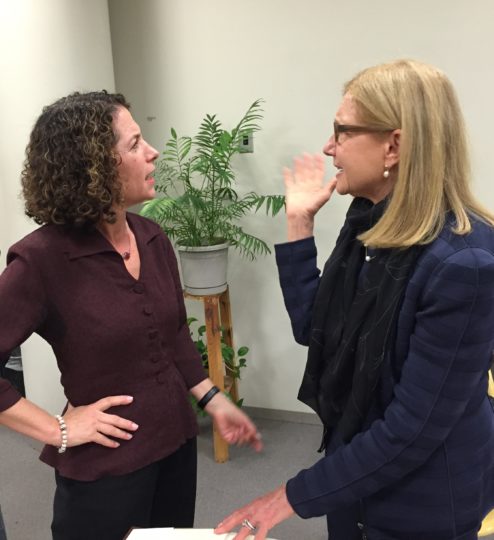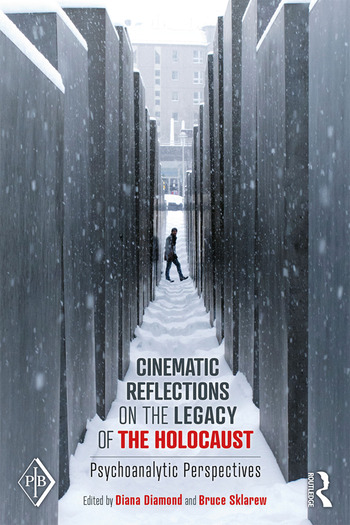Dr. Diamond has written on the application of psychological concepts to understanding narrative and symbolism in cinema. Her work explores how the similarity of moving images and sound in film to dream, daydream, and fantasy allows access to unconscious processing of experience, internal and external. A focus of her work is on the cinematic representation of individual and historical trauma. Her book, Cinematic Reflections on the Legacy of the Holocaust: Psychoanalytic Perspectives (Routledge Press, 2008), offers a psychoanalytic approach that elucidates the themes underlying cinematic representations of individual and historical trauma, such as repetition compulsion, survivor guilt, disturbances in identity, and disruption of mourning. She has also focused on representations of women in film and the unique gaze of female directors. She has taught and lectured internationally on these topics, including at the American Psychoanalytic Association (APsaA), the NYU Postdoctoral Program in Psychotherapy and Psychoanalysis, the William Alanson White Institute, and the bi-annual European Psychoanalytic Film Festival (EPFF), a conference co-sponsored by the International Psychoanalytic Association (IPA), the British Psychoanalytic Institute, and BAFTA. She was also a featured speaker on a panel for the IPA centennial conference Spotlight on the Archive. Film and Psychoanalysis in Focus. Screening Women, where she spoke about the film Hannah Arendt by Marguerite Von Trotta and Pam Katz. She has also consulted with filmmakers on psychoanalytic issues.
Publications & Presentations
Books:
Diamond, D. and Sklarew, B. (Eds.) (2018). Cinematic Reflections on the Legacy of the Holocaust: Psychoanalytic Perspectives. Rutledge Press.
Book Chapters:
Diamond, D. & Jurist, E. (2018). Multiplicity, dissociation, and mentalization in Hannah Arendt by Pam Katz and Margarethe von Trotta. In D. Diamond & B. Sklarew (Eds.), Cinematic Reflections on The Legacy of the Holocaust (pp. 85-121): London & New York: Routledge.
Diamond, D. (2011). Sofia Coppola’s Marie Antoinette: Costumes, girl power, and feminism. In A. Munich (Ed.), Fashion and Film (203-231). Bloomington & Indianapolis: Indiana University Press.
Diamond, D. (2007). Loss, mourning and desire in midlife: Francois Ozon’s Under the Sand and Swimming Pool. In A. Sabbadini, (Ed.), Projected shadows: further psychoanalytic reflections on European cinema (pp. 145-159). Hove and New York: Brunner-Routledge.
Diamond, D. (2003). Sight and Sound in Szabo’s Sunshine: The cinematic representation of historical and familial trauma. In A. Sabbadini (Ed.), The couch and the silver screen: Psychoanalytic reflections on European cinema (pp. 100-116). Hove and New York: Brunner- Routledge.
Peer-Reviewed Journal Publications:
Diamond, D. (2016). The Red Shoes: A fairy tale within a ballet within a film. Psychoanalytic Psychology, 33 (Suppl 1), S104-S119.
Diamond, D. (2011). In Front of the Camera, Behind the Camera: Ullmann Directs Bergmann. Projections, 5, 51-74.
Diamond, D. (2008). Empathy and identification in von Donnersmarck’s The Lives of Others. Journal of the American Psychoanalytic Association, 56(3), 811-832.
Diamond, D. (1999). Narrating Desire and Desiring Narration: A Psychoanalytic Reading of The English Patient. International Journal of Psychoanalysis, 80(2), 385-389.
Invited Publications to Non-Peer Revised Journals:
Diamond, D. (2007). Passion for Survival in Polanski’s The Pianist. Psychoanalytic Inquiry, 27(4), 425-439.
Diamond, D. (2007). Attachment Disorganization and Creativity in Fanny and Alexander by Ingmar Bergman.Psychoanalytic Inquiry, 27, 474-486.
Edited Journal Issues:
Diamond, D., Wrye, H. & Sabbadini, A. (Eds.) (2007). Psychoanalytic visions of cinema/cinematic vision of psychoanalysis. Psychoanalytic Inquiry. 27:4. Philadelphia, PA.: Routledge Press.
Diamond, D. & Wrye, H. (Eds.) (1998). Projections of psychic reality: A centennial of film and psychoanalysis. Psychoanalytic Inquiry, 18. Hillsdale, N.J.: Analytic Press.

Invited Lectures and Presentations:
Diamond, D. (2022, November). The Red Shoes: The Border between creativity, eros and death. Paper presented at the New York University Postdoctoral Program in Psychotherapy and Psychoanalysis film discussion group.
Diamond, D. (2018, December).Cinematic reflections on the legacy of the holocaust in film: Psychoanalytic perspectives.Paper presented at the William Alanson White Institute, Clinical Education Meeting, New York, N.Y.
Diamond, D. (2018, May). Hannah Arendt. In Carolyn Bainbridge (Chair). Spotlight on the Archive. Film and Psychoanalysis in Focus. Screening Women. Paper presented as part of a conference celebrating 100 years of The International Journal of Psychoanalysis (1920-2019). Sponsored by the International Journal of Psychoanalysis and Media and the Inner World, London, UK.
Diamond, D. (2017, January). Multiplicity, Dissociation and Mentalization in “Hannah Arendt” by Pam Katz and Marguerite von Trotta. In Bruce H. Sklarew, M.D. (Chair). Film workshop 1. Symposium conducted at the American Psychoanalytic Association National Meeting. New York, NY.
Diamond, D. (2015, February). Hannah Arendt and the banality of evil. In D. Diamond (Chair and Moderator), A Special Screening of Hannah Arendt. Panel conducted at the Graduate Center, City University of New York, N.Y., N.Y.
Diamond, D. (2013, January). Discussion. In Chair: Bruce Sklarew. Psychoanalysis and Film: The persistence of memory: Two films of Alain Resnais. Symposium conducted at the American Psychoanalytic Association.
Diamond, D. (2011, January). The Red Shoes: A Ballet, A Fairy Tale, A Dream Within a Dream. In Bruce Sklarew (Chair). Film, Fairy Tales and Mythology. Film workshop conducted as at the American Psychoanalytic Association, National Meeting, New York, N.Y.
Diamond, D. (2011, November). The Red Shoes. In K. Dancyger (Chair): Myth, fairy tale and film: creating on the border between the real and the imaginary. Paper Presented at the Sixth European Psychoanalytic Film Festival (EPFF6). The Institute for Psychoanalysis and the British Film Institute (BAFTA), London, England.
Diamond, D. (2010, June). In front of the camera: Behind the camera. Ullman directs Bergman. In Bruce Sklarew (Chair). The Role of the Erotic Imagination. Symposium conducted at the 99th Annual Meeting, American Psychoanalytic Meeting. Washington D.C.
Diamond, D. (2009, October). Transformations in the Internal World of Self and Object Representations in the Late Works of Ingmar Bergman. Presented at the Fifth European Psychoanalytic Film Festival (EPFF5), British Academy of Film and Television Arts, organized by the Institute of Psychoanalysis, London, U.K.
Diamond, D. (2007, November). Empathy and Identification in The Lives of Others. In Donald Campbell, M.D. (Chair). Symposium conducted at the Fourth European Psychoanalytic Film Festival (EPFF4). The Institute for Psychoanalysis and the British Film Institute, London, England.
Diamond, D. (2005, November). Loss, Mourning and Desire in Midlife: A study of Under the Sand and The Swimming Pool by Francois Ozon. Paper presented at the Third European Psychoanalytic Film Festival (EPFF3), The Institute for Psychoanalysis and the British Film Institute, London, England.
Diamond, D. (2005, January). Attachment Disorganization and Creativity in Fanny and Alexander by Ingmar Bergman. In Bruce Sklarew, Chair. The films of Ingmar Bergman, Symposium conducted at the American Psychoanalytic Associations Meetings, New York, N.Y.
Diamond, D. (2003, November). Passion for Survival in Polanski’s The Pianist. Paper presented at the Second European Psychoanalytic Film Festival (EPFF2), The Institute for Psychoanalysis and the British Film Institute (BAFTA), London, England.
Diamond, D. (2002, April). The Cinematic Representation of Historical and Familial Trauma. Paper presented as part of a symposium Trauma and Art: Clinical and Cinematic Applications. The 22nd Annual Spring Meeting of the Division of Psychoanalysis (39) of the American Psychological Association New York.
Diamond, D. (2001, November). Sight and Sound in Szabo’s Sunshine: The Cinematic Representation of Historical and Familial Trauma. Paper presented at the First European Psychoanalytic Film Festival (EPFF1) sponsored by the British Psychoanalytic Society, the International Psychoanalytic Association, The British Film Institute, and The European Psychoanalytic Federation, London, England.
Courses:
Graduate courses in the doctoral program for clinical psychology at the City University of New York (CUNY)
- Psychological Process Through Film (designed and taught course 1994-1997)
